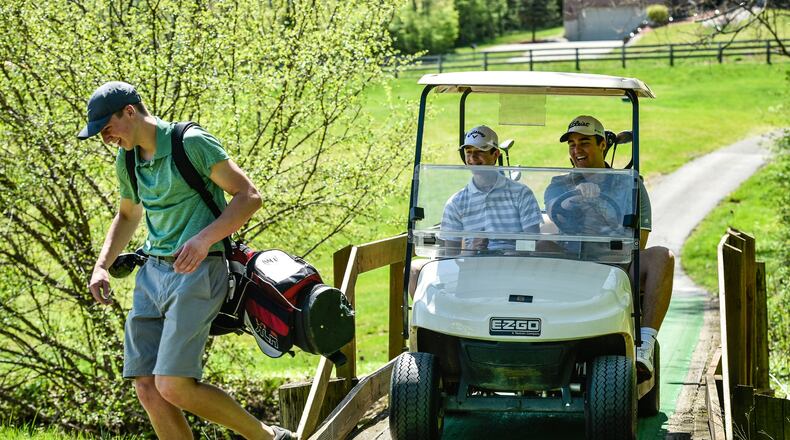“It was a good year for us last year,” said Adam Helms, general manager of the courses. “We did raise prices by a dollar (for a round), so that helped a little bit.”
At Potter’s, 23,050 rounds were played in 2017, up 10.8 percent from 20,802 the prior year.
At Twin Run, golfers played 24,390 rounds, up 20.7 percent from 20,212 in 2016.
Potter’s had $76,000 in concession revenues, compared to $103,000 at Twin Run.
Of the $1.13 million in revenues, $900,000 came from golf, including green fees, season passes and cart rentals; while $179,000 came from concessions; and $53,000 came from miscellaneous revenues, including a cell-phone tower at Potter’s and interest income.
“Weather plays a key part of it,” Helms said about rounds played and concessions sold. Another factor: 2017 was the first season that the Weatherwax Golf Course, once owned by the city of Middletown and briefly by Myron Bowling, was not in operation, so Hamilton’s courses likely received play from Middletown-area players, along with others from the former Vista Verde Golf Course in Liberty Twp.
“Since I’ve been running the golf courses (starting in 2013), we’ve only had two years when we lost money,” Helms said.
The first year’s deficit was attributed to a golf superintendent’s retirement, which required unexpected payouts of vacation and retirement funds.
Then the courses lost a combined $34,291 in 2016 because of a brutally hot summer with several heat warnings and high humidity.
“The weather this year is killing us,” Helms said. “Compared to last year, just speaking revenues, we’re about $110,000 behind in revenues compared to this time last year, and it’s because of the brutal spring — nobody wanted to play golf. And there were a lot of days where we were closed because of snow.”
“We generally don’t open unless the temperature’s above 40 degrees,” Helms added. “Even then, the few days we had above 40, it was raining.”
Some leagues, with 50-60 players each, also were supposed to start weeks ago, but have seen delays. This spring’s deficit will be difficult to make up, even with a perfect August, Helms said.
When the city started managing the courses, the golf fund had a balance of $135,474. Its balance at the start of this year was $299,423.
Six-time Hamilton city golf champion Kyle Hodges, 31, is very thankful his hometown has two nice courses, which provide affordable play in what otherwise can be an expensive sport.
“Having affordable access to golf I think is a challenge in a lot of cities,” Hodges said. “I think in Hamilton we’re blessed to have two courses that are always in pretty good shape, that are affordable for us.”
“And I think you don’t have to look any farther than Middletown, what they’ve gone through with Weatherwax,” he added. “I think this summer residents in Middletown are really going to be probably hurting when it comes to golf, because that was such a great place to play for them, and they’re not going to have that anymore.”
Steve Jurick, executive director of the Miami Valley Golf Association, calls golf courses “a very efficient way to provide assets to a community,” including quality of life and entertainment, plus the job-creation potential of a sport for business leaders. Nine percent of the country’s population plays golf, he said.
In 2013, when Hamilton’s own city staff started caring for the courses, the clubhouses, each about 20 years old, needed significant improvements, and many capital needs had been postponed for years. That has changed.
“Last year we put a new roof on at Potter’s, this year we put a new roof on at Twin Run,” Helms said.
The secret to the city’s success in operating golf courses, while other municipal courses have struggled?
“One of the things we do differently that some courses don’t do is we own our fleet of carts out at Twin Run,” Helms said, “whereas at Potter’s, we’re currently leasing them.”
A long term goal is to buy carts for Potter’s outright to avoid the annual rental fees.
The city also has bought some equipment, such as aeration machinery, which saves $10,000 to $15,0000 per year. Hamilton officials also bought a new greens mower at Potter's Park, and, "we've had a lot of good comments already this year about how the greens are rolling," he said. "It's amazing what a new piece of equipment will do, versus running greens mowers that were 20-something years old."
The city also bought a specialized blade sharpener purchased from the now-closed Weatherwax.
“A lot of cities out there don’t even have one course, so we’re fortunate to have two of them,” Helms said. When a tournament occupies one of the courses for an afternoon, the other one remains open for players not participating in the tournament.
In a nationwide effort to increase play by youths, the Greater Cincinnati Golf Association is running a national program called Youth On Course. Youths enrolled in the program can play 9 holes for $3, or 18 holes for $5 between 11 a.m. and 12:30 p.m., and weekends after noon.
Jurick applauded Hamilton for the program to encourage youth play. Among other things, it gets kids outside and away from video games. Also, golf teaches players how to enforce the game’s rules on themselves, in a sport where referees are not standing over their shoulders, he said.
About the Author
